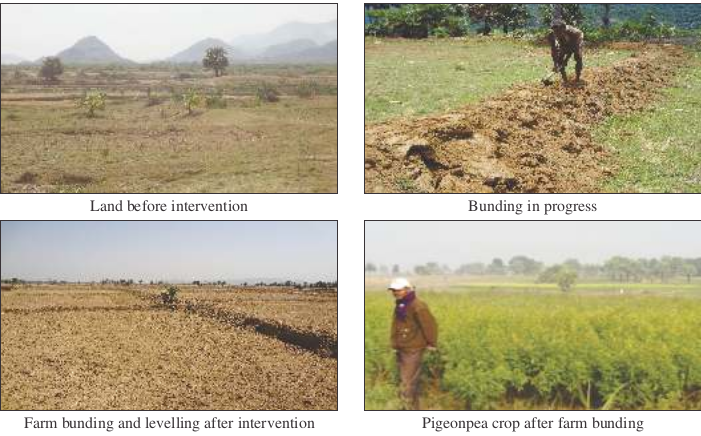Improving the resilience of poor farmers by reclaiming cultivable wastelands
Improving the resilience of poor farmers by reclaiming cultivable wastelands
Climate vulnerability
Drought, soil erosion and land degradation
Existing practice
Cultivable wastelands located in the fringe areas of the forests are not cultivated regularly despite being fertile. Besides, the undulated lands require leveling and bunding. Poor farmers lack the investment required to make these lands cultivable. A few enterprising farmers now and then broadcast seeds of horse gram or redgram and harvest some grains depending on the season. Most households continue to remain poor despite owning fertile land. Some farmers cultivate these lands for a while and abandon cultivation after the bunds disappear due to runoff erosion. These lands completely depend on rainfall for cultivation as the traditional rainwater harvesting and storage structures (ahars) cannot convey water to these lands due to their higher elevation. As a result the land remained fallow over time, unprotected from overgrazing leading to soil erosion and deprived the farmers of their livelihood.
Resilient practice / technology
Scientists of KVK-Sokhodeora, Nawada, Bihar evolved a systematic programme to bring the cultivable fallow land back into crop production by motivating the community to participate in reclaiming the lands by leveling and bunding . The community initially was hesitant due to past experience. As per the plan, each farmer actively participated by contributing his labour in laying out the bunds while the project facilitated leveling of the land. Farmers took up shapening of the bunds with increased height for better in situ rainwater conservation and to prevent erosion by runoff. The process of laying bunds started during later part of kharif season (2011) and went on until the beginning of summer, 2012. Those farmers who could complete bunding and leveling early, planted pigeonpea and short duration paddy. The experience of these farmers was encouraging and many farmers started participating in this programme with renewed vigor and enthusiasm.
Similarly, in Umrani village of Nandurbar district, Maharastra, the soils are shallow and are prone to moderate to severe soil erosion. Hence, trench cum bunding practice was demonstrated in 67 ha area covering 167 farmers' fields in order to trap the top fertile soil in trenches, allowing safe disposal of excess rainwater and to conserve precious soil moisture.
Impact
In Sokhodeora village, about 15 ha was planted with pigeonpea during kharif 2012 leading to harvest of 10,000 kg of pigeonpea worth Rs.3,50,000. For the first time, the farmers of these villages could realize such a harvest and this helped them to appreciate the worth of their land due to bunding and leveling.
The outcome of this intervention caught the attention of farmers in the neighboring village of Upper Manjhila. About 4 ha of land belonging to 13 farmers remained fallow due to undulated topography and unabated erosion. These farmers contributed labour for bunding and leveling of their lands. Community participation in this bunding and leveling intervention drew the participation of many more into the NICRA project. Having witnessed the effect of this intervention over the past two years, a large group of farmers (107) came together and raised the height of their field bunds in about 24 ha during early kharif 2013 period when this area experienced delay in onset of monsoon and deficit rainfall conditions. The raised bund height was useful in harvesting and conserving rainwater for a successful late kharif crop or in some cases an early rabi chickpea crop.
Similarly, at Umrani village, the soil trapped due to trench cum bunding was in the range of 11.5-21.2 m3/ acre. The farmers could save the valuable top soil being eroded from their fields with the treatment of trench cum bunding. Since the benefits of trench cum bunding were very significant, up scaling of the technology was taken up in convergence with MGNREGA on 229 farmers' fields. An amount of Rs 8,00,000 was sanctioned for this intervention by the district authority as convergence.

Scope for upscaling
Land improvement through leveling and bunding in slopy cultivable wastelands in upland areas can systematically bring back farming opportunities to small and marginal farmers and also arrest the unabated land degradation. Such land improvement activities require careful planning and critical need assessment. Support is possible from Mahatma Gandhi National Rural Employment Guarantee Programme (MGNREGP) and the Integrated Watershed Development Programme (IWMP) in Bihar, Jharkhand, Chhattisgarh and Odisha.
Source: Smart Practices and Technologies for Climate Resilient Agriculture
Last Modified : 2/12/2020
This topic provides information about Check dams f...
This topic provides information about Captive rear...
This topic provides information about Community ta...
This topic provides information about Crop diversi...
